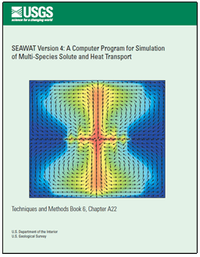The SEAWAT program is a coupled version of MODFLOW and MT3DMS designed to simulate three-dimensional, variable-density, saturated ground-water flow. Flexible equations were added to the program to allow fluid density to be calculated as a function of one or more MT3DMS species. Fluid density may also be calculated as a function of fluid pressure. The effect of fluid viscosity variations on ground-water flow was included as an option. Fluid viscosity can be calculated as a function of one or more MT3DMS species, and the program includes additional functions for representing the dependence on temperature. Although MT3DMS and SEAWAT are not explicitly designed to simulate heat transport, temperature can be simulated as one of the species by entering appropriate transport coefficients. For example, the process of heat conduction is mathematically analogous to Fickian diffusion. Heat conduction can be represented in SEAWAT by assigning a thermal diffusivity for the temperature species (instead of a molecular diffusion coefficient for a solute species). Heat exchange with the solid matrix can be treated in a similar manner by using the mathematically equivalent process of solute sorption. By combining flexible equations for fluid density and viscosity with multi-species transport, SEAWAT Version 4 represents variable-density ground-water flow coupled with multi-species solute and heat transport. SEAWAT Version 4 is based on MODFLOW-2000 and MT3DMS and retains all of the functionality of SEAWAT-2000.
SEAWAT Version 4 also supports new simulation options for coupling flow and transport, and for representing constant-head boundaries. In previous versions of SEAWAT, the flow equation was solved for every transport timestep, regardless of whether or not there was a large change in fluid density. A new option was implemented in SEAWAT Version 4 that allows users to control how often the flow field is updated. New options were also implemented for representing constant-head boundaries with the Time-Variant Constant-Head (CHD) Package. These options allow for increased flexibility when using CHD flow boundaries with the zero-dispersive flux solute boundaries implemented by MT3DMS at constant-head cells.
This report contains revised input instructions for the MT3DMS Dispersion (DSP) Package, Variable-Density Flow (VDF) Package, Viscosity (VSC) Package, and CHD Package. The report concludes with seven cases of an example problem designed to highlight many of the new features.


